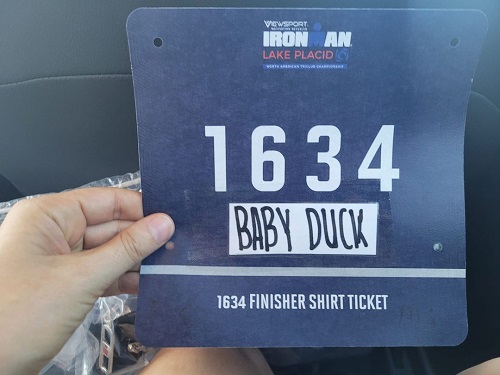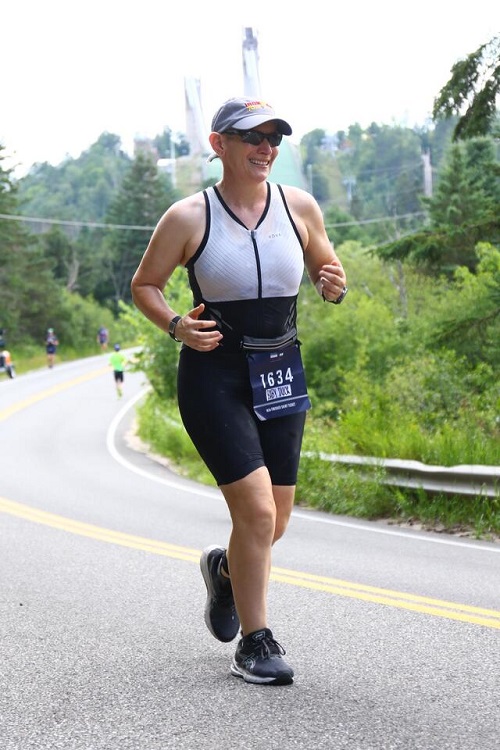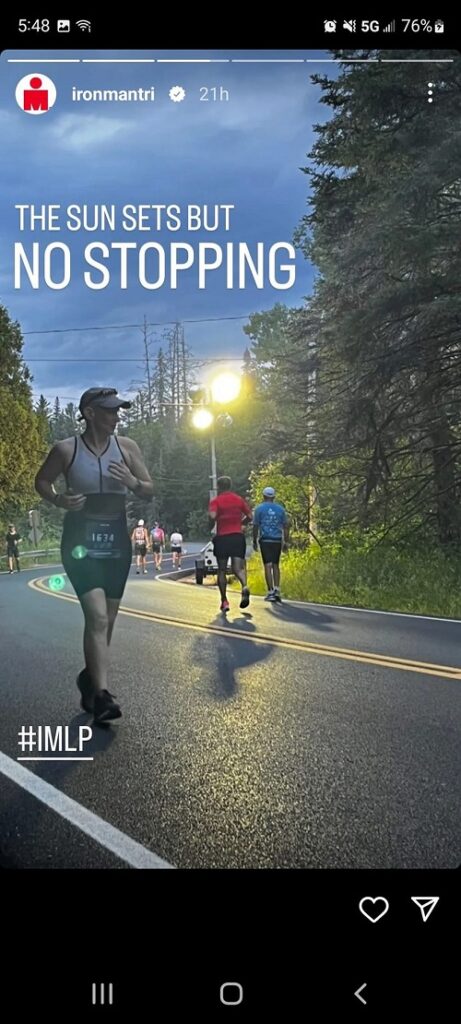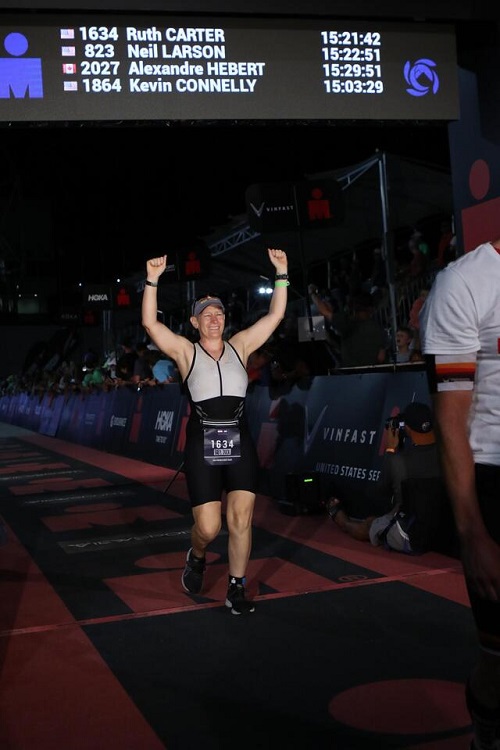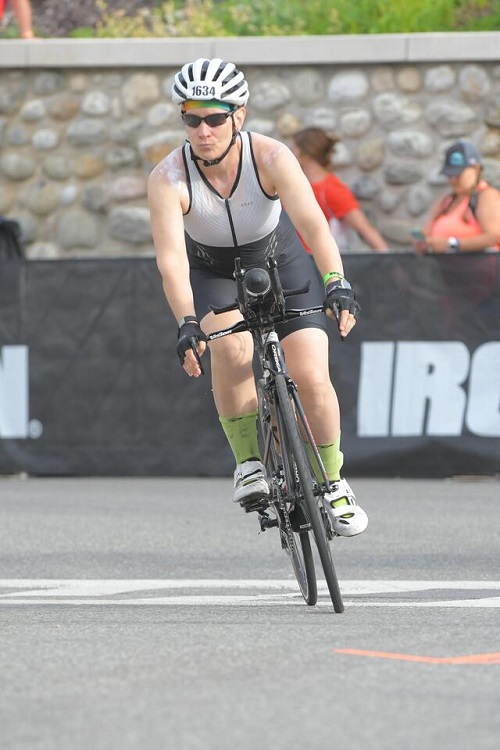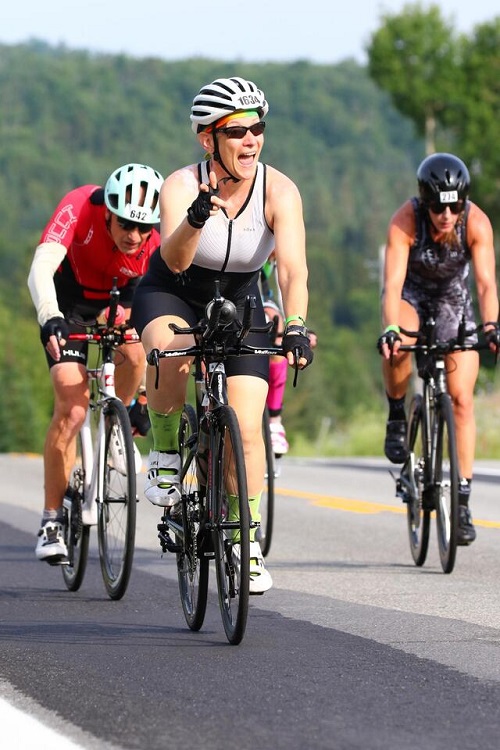I’ve shared the details of my experience with the three sections of Ironman Lake Placid: the 2.4-mile swim, the 112-mile bike, and the 26.2-mile run. Now, I want to tell you about some of the supporters and volunteers who helped make this an amazing experience.

Leading Up to the Race
In addition to Coach David, who I talked or texted with almost daily, another person who was instrumental in my Ironman journey was my physical therapist, Kristina. Already an Ironman herself, she helped keep my body working through the training, especially my hips and back. I was on the physical therapy table every other week for months leading up to my race, getting ASTYM and other body manipulations. After the race, she put me in compression boots for 30 minutes, which was instrumental for relieving my sore muscles.
My friends were also supportive, regularly asking about my workouts and how I was feeling the last few days before I flew to New York. I was a bundle of excitement and nerves. A few days before I left, I received good luck cards: one from my farm family and on from my officemates. I took both cards with me on the trip and kept them out on the table in my hotel, serving as constant reminders of support from afar.
On the day before the race, my friends filled my phone with text messages that said, “Good luck,” “So proud of you,” and “We’re all praying for you.”
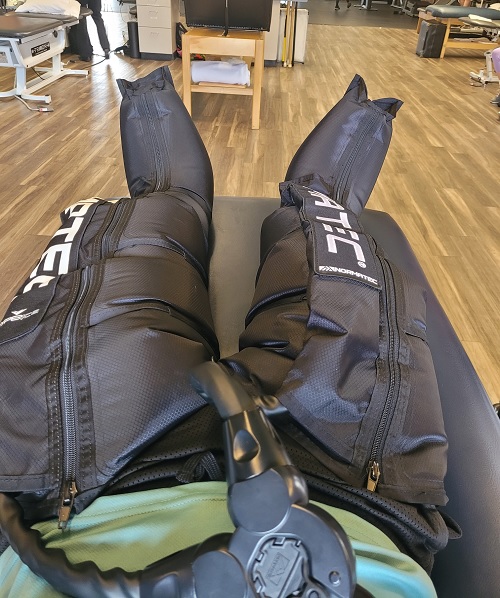
Race Volunteers
I could not talk about the many people who supported me along my Ironman journey without talking about the race volunteers. Over 1800 people volunteered their time to make Ironman Lake Placid possible.
The race volunteers were involved in nearly every aspect of my race experience. You couldn’t miss them in their bright neon green t-shirts. They were at race registration where we got our race numbers and gear bags. They were in the transition area both the day before and on race day. They made up the set up and clean up crews. They were also the lifeguards, paddleboarders, and kayakers at the lake. (I heard there were also scuba divers in the lake in case anyone drowned.)
They were the “strippers” who peeled off our wetsuits. They worked all the aid stations during the bike and run, handing out supplies in the hot sun and into the night. They were the medics. They were the people who put the medals around our necks after we crossed the finish line.
Thank You 2022 IRONMAN Lake Placid Volunteers!This race wouldnt be possible without our AMAZING volunteers. Thank you for all your hard work and dedication to IRONMAN Lake Placid. Show our volunteers some love in the comments!
Posted by IRONMAN Lake Placid on Thursday, July 28, 2022
One of the perk of volunteering at an Ironman race is you get an earlier chance to register for the next year’s race. For Ironman Lake Placid 2023, this year’s racers had first dibs, then that race’s volunteers, and then registration was open to the general public. Apparently some races fill up so fast that you almost have to volunteer to get a slot to be in next year’s race.
Yes, people sign up a year in advance to do an Ironman race.
I made an extra effort to thank all the volunteers I interacted with for being there. I know from experience that watching people race isn’t the most fun way to spend a day.

The White Bracelets
Each racer received a white rubber bracelet when we picked up our gear bags at registration. This bracelet wasn’t for us per se but for us to give as a “gold star” and to say thank you to a volunteer who helped us during the race.
I love that Ironman acknowledges its volunteers and gives us a way say special thanks to a volunteer who made a difference in our race.
I gave my white bracelet to a volunteer in the transition area. I’d finished the swim, changed my clothes, grabbed my bike, and was walking it to the beginning of the bike portion when I noticed the lenses of my sunglasses were smudged. Given that I was wearing only a spandex onesie, I had nothing to wipe them on.
As I walked towards the bike start, I spotted a volunteer in her neon green cotton t-shirt.
Cotton!
I paused next to her and asked if I could wipe my glasses on her shirt. She took my sunglasses from me, expertly wiped each lens with the hem of her shirt, and handed them back to me.
Much better!
I thanked her as I slid my white bracelet off my wrist and handed it to her.

Support from the Whole Community
Lake Placid and surrounding communities welcomed the Ironman invasion one weekend a year. There were definitely more than just the family and friends of the racers in the sea of people who cheered us on throughout the day.
Many of these supporters stayed out with us all day. Even after the sun went down, they were still there. Some of the locals invited their friends over and set up camp in front of their homes to watch us. As I ran past one group, I got the distinct vibe of “this is what we do.” Living on the race route meant you hung out to watch and cheer.
One sweet-looking older lady stood on her driveway and watched the parade of racers go by in their spandex. I wonder if she was particularly interested in the younger guys’ butts.
Even the people who were obviously there for one person wearing matching shirts, and holding signs or giant heads of their loved ones were cheering everyone on.
They all got it.
Whether they’d done an Ironman race before or not, they knew we were pushing ourselves through this incredibly difficult challenge. I could feel the vibe of “We honor what you’re doing” coming from all of them. I hope they understand how much their presence meant.

Human Car Wash
Several people who lived along the run route set up what I called the “human car washes” at the side of the road. It’s a garden hose attached to a rectangular frame of PVC pipe with holes on the interior, so when the water’s turned on, sprays of water shoot inward. When you walk through this, you get a cool spray of water all over your body.
Some people, like me, gratefully walked through each of these human car washes. Others used them to rinse the film of sweat, dirt, and Gatorade from their hands; they didn’t want to their shoes, and therefore their feet, wet.
These were a highlight of the end of my race and supplemented the cups of ice I picked up at each aid station. These supporters ran their human car washes for hours, running up their water bill to keep us cool.

Hat Tip to the Strawberry Blonde Volunteer
There was a volunteer who worked inside the women’s changing tent during T2 with a long strawberry blonde hair ponytail. She was loud, but not in a bad way, making sure we all knew she was there for whatever we needed – water, Vaseline, reminders of where to put our gear bags, whatever.
She never sounded bored or distracted, even though she was in that poorly ventilated tent for hours, saying the same things over and over again. The population of the changing tent turned over every 10ish minutes, and she was present and available for whoever needed her.
What really showed me about how dedicated she was to supporting us was the fact that I saw her again while I was on my second lap of the run. This time she was in crowd at the side of the street. She was still in her neon green volunteer shirt, but her shift was over. Even though she had no obligation to be there, she was still there cheering us on. I noted many
white bracelets on her wrist, each one well deserved.

Messages on my Phone
The last thing I want to share about the amazing supporter I had during my race is the many messages I received after the race. I left my phone in my hotel room as earbuds are not allowed during the race.
Here’s a sampling of the messages that were waiting for me when I got back to my hotel room:
- “Congratulations!!!! You did it!!! You are a legit Ironman!!! Simply amazing. I can’t wait to hear all about. Now get some rest and eat some good food!!”
- “15:21:42 holy fucking shit that’s AMAZING I’M SO PROUD OF YOU!!!!!”
- “So awesome and so proud of you. I have been following you all day!”
- “YOU DID IT!!!!!! CONGRATS!!”
It felt so good to know that my friends were keeping an eye on my progress throughout the day. It felt like a long-distance hug.
Next week: the last chapter of my 2022 Ironman Lake Placid experience – your questions answered!
